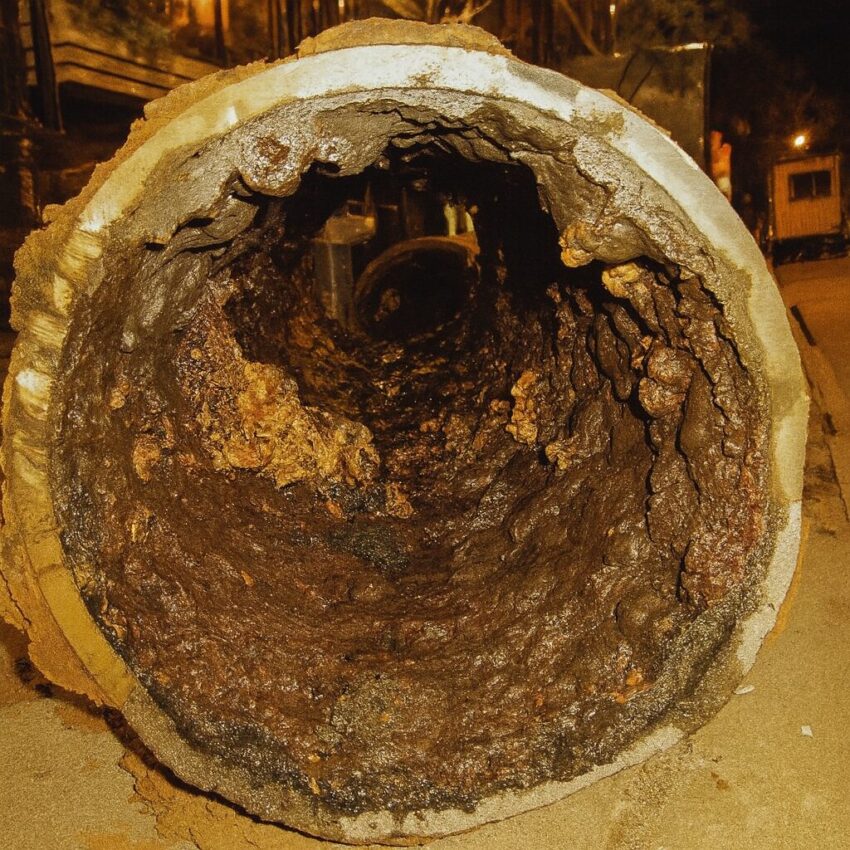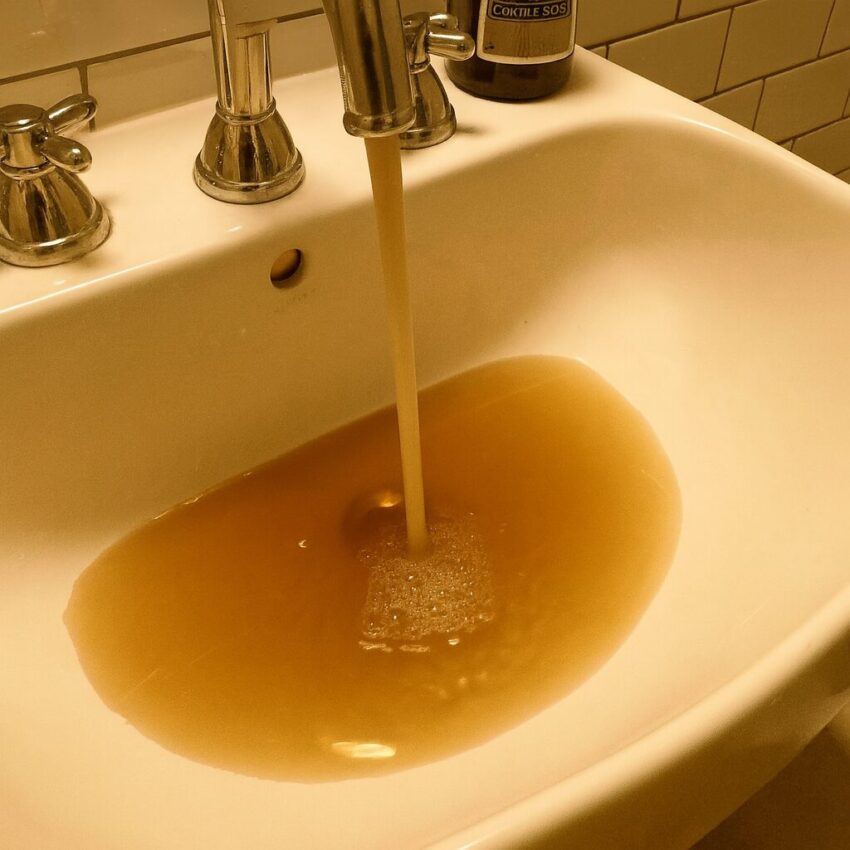Why Does My Community Have Brown Water?

Brown water from your tap is one of those problems that looks worse than it usually is. When residents see discolored water, they understandably worry about safety and quality. The truth is, most brown water comes from fairly simple causes within our aging water systems. Understanding these causes helps communities push for the right fixes and know when to actually be concerned.
Common Causes of Water Discoloration
Municipal water systems are complex networks of pipes, pumps, and storage tanks. When something disrupts the normal flow, you often see it in your water’s color.
Aging Infrastructure and Pipe Corrosion: Here’s the reality – many Colorado towns still use iron pipes installed 60, 70, even 100 years ago. Iron rusts. That’s not news to anyone. This rust builds up inside pipes year after year, creating a crusty layer that usually stays put. But when water pressure changes suddenly, chunks of rust break free and flow straight to your faucet. Towns with pipes from the 1920s through 1960s deal with this constantly.
System Maintenance and Repairs: Water departments have to fix broken pipes and maintain the system – there’s no way around it. But when crews shut down a section for repairs, then turn it back on, it creates a surge that knocks loose years of built-up sediment. That’s why you often see brown water right after utility trucks leave your neighborhood. They fixed one problem but temporarily created another.
Fire Hydrant Operations: Fire hydrants move massive amounts of water – far more than pipes normally handle. Whether firefighters are battling a blaze or the water department is doing routine testing, opening those hydrants creates powerful flows that scour pipes clean. All that loosened material has to go somewhere, and unfortunately, that somewhere is often your kitchen sink.
Seasonal and Environmental Factors: Colorado weather doesn’t make things easier. Spring snowmelt carries minerals and sediment into our water sources. Summer thunderstorms dump mud into reservoirs. And those famous Colorado temperature swings? They make underground pipes expand and contract repeatedly, which can crack aging infrastructure and let soil seep in.
Health and Safety Considerations
Let’s address the big question – is brown water safe? In most cases, yes. The iron and manganese that typically cause discoloration aren’t harmful at the levels found in tap water. These are what the EPA calls secondary contaminants, meaning they affect how water looks and tastes but not your health.
Still, nobody wants to drink murky water. Here’s what to do when it happens:
First, run your cold water for 10-15 minutes. Start with the bathtub since it has the largest pipes. This usually flushes out whatever got stirred up. Avoid using hot water until things clear up – sediment can settle in your water heater and cause problems later.
Hold off on laundry, especially whites. Iron stains are nearly impossible to remove once they set. Just wait until your water runs clear again.
If brown water persists more than a day, call your water department. Sometimes there’s a bigger issue that needs attention. They need to know about persistent problems to prioritize repairs.
Municipal Strategies for Water Quality Management
Water departments don’t just react to complaints – they work to prevent problems before they start. Here’s how most communities tackle brown water:
Infrastructure Replacement Programs: The ultimate fix is replacing old iron pipes with modern materials that don’t corrode. But replacement costs millions and requires tearing up streets. Most towns create 20-30 year plans, replacing the worst pipes first. It’s slow progress, but it’s the only permanent solution.
Proactive System Flushing: You’ve probably seen water gushing from hydrants into the street and wondered about waste. That’s actually intentional flushing to remove sediment before it causes problems. Smart utilities flush systematically, neighborhood by neighborhood, to keep pipes cleaner year-round.
Corrosion Control Treatment: Water plants add carefully calculated amounts of phosphates or other compounds that form a protective coating inside pipes. Think of it as a barrier between the metal and water. Getting the chemistry right takes expertise, but it significantly reduces rust problems.
Pressure Management Systems: Since pressure changes knock sediment loose, many systems now use special valves and controls to maintain steady pressure. This not only reduces brown water events but also prevents pipe breaks and extends infrastructure life.

Community Engagement and Action Steps
Residents shouldn’t just accept frequent brown water as normal. Here’s how to push for improvements:
Start documenting problems. Note dates, duration, and severity. Take photos. This information helps utilities identify patterns and prioritize fixes.
Attend town meetings. Ask specific questions: What’s the pipe replacement schedule? Are we pursuing infrastructure grants? Why do some neighborhoods have more problems than others? Your voice matters, especially when combined with neighbors facing similar issues.
Understand funding options. Colorado offers several grant and loan programs for water infrastructure. When residents support appropriate rate increases or bond measures, utilities can accelerate improvements. Nobody likes paying more, but modern infrastructure costs money.
Modern Engineering Solutions – Your Community Firm
At Modern Engineering Solutions, we help Colorado communities solve water quality problems through smart engineering and practical planning. We’re licensed professional engineers who understand both the technical challenges and budget realities facing water systems across our state.
We don’t just identify problems – we design affordable solutions. Our services include evaluating your distribution system, creating replacement priorities based on real data, and helping secure state and federal funding. We’ve helped communities from small mountain towns to growing Front Range cities improve their water quality and reliability.
Our approach is straightforward. We assess your system, identify the worst problem areas, and create a practical plan to fix them. We help you understand funding options and design improvements that fit your budget. No overwhelming technical jargon – just clear explanations and solid engineering.
Brown water frustrates residents and reflects poorly on communities. But it’s fixable with the right approach and investment. If your town struggles with water quality issues, Modern Engineering Solutions can help chart a path forward. We’ll work with your utility to develop solutions that deliver the clear, reliable water your residents deserve.
Contact us to discuss your water system challenges. Together, we can eliminate brown water problems and build infrastructure that serves your community for generations.
